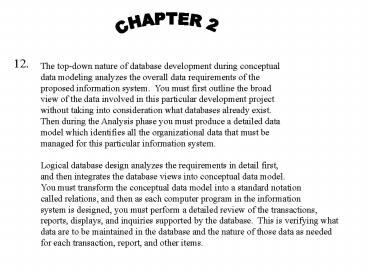The topdown nature of database development during conceptual PowerPoint PPT Presentation
1 / 2
Title: The topdown nature of database development during conceptual
1
CHAPTER 2
12.
The top-down nature of database development
during conceptual data modeling analyzes the
overall data requirements of the proposed
information system. You must first outline the
broad view of the data involved in this
particular development project without taking
into consideration what databases already exist.
Then during the Analysis phase you must produce
a detailed data model which identifies all the
organizational data that must be managed for this
particular information system. Logical
database design analyzes the requirements in
detail first, and then integrates the database
views into conceptual data model. You must
transform the conceptual data model into a
standard notation called relations, and then as
each computer program in the information system
is designed, you must perform a detailed review
of the transactions, reports, displays, and
inquiries supported by the database. This is
verifying what data are to be maintained in the
database and the nature of those data as needed
for each transaction, report, and other items.
2
13.
An ideal location to develop a prototype would be
on a department computer. An enterprise server
would need to be constructed using the
traditional step method. By developing a
prototype on a department computer would allow
the organization to select exactly what they
want. It would also be more efficient and lest
costly. Personal computers are developed for
the individual user and would not be
beneficial to use for the entire company.
15.
Duplication of data takes up storage space and
causes an increased effort to keep all files up
to date. Duplicate data files often result in a
loss of data integrity since the data formats
may be inconsistent or data values may be
different. This can also lead to loss of
metadata integrity. The same data item may have
different names in different files, or the same
name may be used for different data items in
different files. Duplication of files could
result from accounts payable and cash flow
analyst both recording the payment of a bill to a
vendor, but having different figures. This
duplication would violate the principles of the
database approach outlined in Chapter 1 because
the data wouldnt flow efficiently due to the
possibility of duplication.

